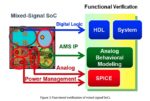My first job out of college was migrating a DRAM chip from one process node to a newer node, and it was a 100% manual process that required many months of effort. That need to migrate semiconductor IP to newer nodes is still with us today, and much automation has been applied to digital circuits, however migrating analog IP has proven… Read More
Tag: analog ip
Overcoming obstacles with mixed-signal and analog design integration
Mixed-signal and analog design are key aspects of modern electronics. Every chip incorporates some form of analog IP, as even digital logic is dependent on analog signals for critical functions. Many digital design engineers are known to be uncomfortable with the prospect of integrating analog components. However, the current… Read More
Podcast EP160: How Agile Analog Makes AMS Integration Easy with Chris Morrison
Dan is joined by Chris Morrison, Chris has 15 years’ experience in delivering innovative analog, digital, power management and audio solutions for International electronics companies, and developing strong relationships with key partners across the semiconductor industry. Currently he is the Director of Product Marketing… Read More
Package Pin-less PLLs Benefit Overall Chip PPA
SOCs designed on advanced FinFET nodes like 7, 5 and 3nm call for silicon-validated physical analog IP for many critical functions. Analog blocks have always been node and process specific and their development has always been a challenge for SOC teams. Fortunately, there are well established and endorsed analog IP companies… Read More
Podcast EP8: A Look Inside Analog IP and Analog Bits
Dan and Mike are joined by Mahesh Tirupattur, executive vice president at Analog Bits. Mahesh discussed how he found his way to analog IP design and his long association with Analog Bits. Effective strategies for analog IP design and deployment are discussed as well as leading edge applications for analog IP . Mahesh also provides… Read More
Analog Bits is Supplying Analog Foundation IP on the Industry’s Most Advanced FinFET Processes
The industry recently concluded a series of technology events for the all the major foundries. Done as virtual events this year, each one provided a significant update on technology platforms, roadmaps and ecosystem partnerships. These events are quite valuable to chip design teams who need to be aware of the latest in process,… Read More
CEO Interview: Murilo Pilon Pessatti of Chipus Microelectronics
Murilo Pilon Pessatti is an Electrical Engineer with a MSEE in Analog IC design. He studied in Brazil at São Paulo University (USP) and earned a masters at Campinas State University (UNICAMP). Murilo then moved to Lisbon in Europe to work for ChipIdea, in the early 2000’s when the smartphone era was just taking off.
“I… Read More
White Paper – Mixed Signal Verification for Nanometer SOCs
The number of touchpoints between analog and digital circuits in high performance SoCs is increasing. This is not a problem because it is possible to implement critical analog blocks directly on nanometer scale digital ICs. However, in many cases digital interfaces or digital feedback circuitry configures these analog blocks… Read More
Webinar on Tools and Solutions for Analog IP Migration
The commonly advanced reason for IP reuse is lower cost and shorter development time. However, IP reuse presents its own challenges, especially for analog designs. In the case of digital designs, once a new standard cell library is available, it is usually not too hard to resynthesize RTL to create new working silicon. For analog… Read More
56th DAC – In Depth Look at Analog IP Migration from MunEDA
Every year at DAC, in addition to the hubbub of the exhibit floor and the relatively short technical sessions, there are a number of tutorials that dive in depth into interesting topics. At the 56th DAC in Las Vegas this year, MunEDA offered an interesting tutorial on Analog IP migration and optimization. This is a key issue for large… Read More









